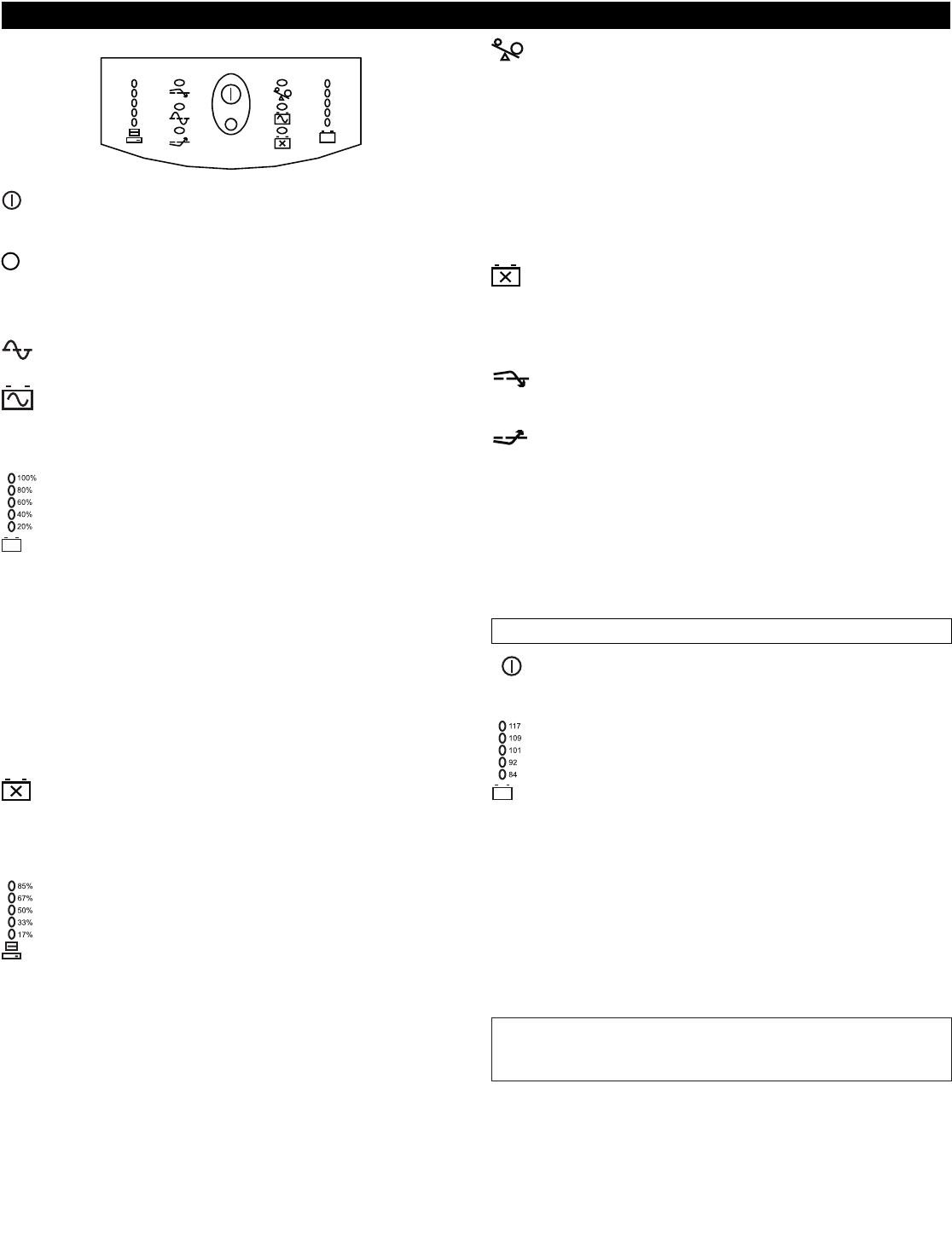
Switch On Ñ Switch Off
With the UPS plugged in, press and release the large upper on/test button to
supply power to the loads. The loads are immediately powered while the UPS
beeps and performs a self-test.
Press and release the small, lower off button to turn off power to the loads. It
may be convenient to use the UPS as a master on/off switch for the protected
equipment.
Note: Whenever the UPS is plugged in and utility voltage is present, the charger
maintains battery charge.
The on-line LED illuminates when the UPS is supplying utility power to the
loads.
On Battery
During on-battery operation, the on-battery LED illuminates and the UPS sounds
an audible alarm consisting of four beeps every 30 seconds. The alarm stops when
the UPS returns to on-line operation.
Battery Charge Bar Graph
The 5-LED display on the right of the front panel shows the present charge of the
UPS’s battery as a percentage of the battery’s capacity. When all five LEDs light,
the battery is fully charged. The top LED goes out whenever the battery is not
100% charged. When the lowest LED is flashing, the battery can supply less than
two minutes of run time for the load.
Shutdown Mode
In shutdown mode the UPS stops supplying power to the load, waiting for the
return of utility power. If there is no utility power present, external devices (e.g.,
servers) connected to the computer interface or the accessory slot can command
the UPS to shut down. This is normally done to preserve battery capacity after the
graceful shutdown of protected servers. The UPS will scroll the front panel indica-
tors sequentially in shutdown mode.
Replace Battery
If the battery fails a self-test, the UPS emits short beeps for one minute and the
replace battery LED illuminates. The UPS repeats the alarm every five hours. Per-
form the self-test procedure to confirm replace battery conditions. The alarm stops
when the battery passes the self-test.
Load Bar Graph
The 5-LED display on the left of the front panel represents the power drawn from
the UPS as a percentage of total capacity. For example, if three LEDs are lit, the
load is drawing between 50% and 67% of the UPS’s capacity. If all five LEDs
light, thoroughly test your complete system to make sure that the UPS will not
become overloaded.
Overload
When the UPS is overloaded (when the connected loads exceed the maximum
specified in the “maximum load” section under Specifications), the overload LED
comes on and the UPS emits a sustained tone. The alarm remains on until the
overload is removed. Disconnect nonessential load equipment from the UPS to
eliminate the overload.
Self-test
The UPS performs a self-test automatically when turned on, and every two weeks
thereafter (by default). Automatic self-test eases maintenance requirements by
eliminating the need for periodic manual self-tests.
During the self-test, the UPS briefly operates the loads on-battery. If the UPS
passes the self-test, it returns to on-line operation.
If the UPS fails the self-test it immediately returns to on-line operation and
lights the replace battery LED.
The loads are not affected by a failed test. Recharge the battery overnight and
perform the self-test again. If the replace battery LED is still on, replace the
battery using the Replacing the Battery procedure.
SmartTrim
The SmartTrim LED comes on to indicate that the UPS is compensating for a high
voltage.
SmartBoost
The SmartBoost LED comes on to indicate that the UPS is compensating for a low
voltage.
Low Battery
When the UPS is operating on-battery and the energy reserve of the battery runs
low, the UPS beeps continuously until the UPS shuts down from battery exhaus-
tion or returns to on-line operation.
Cold Start
When the UPS is off and there is no utility power, use the cold start feature to
apply power to the loads from the UPS’s battery.
Note: Cold start is not a normal condition.
• Press and hold the on/test button until the UPS beeps.
• Release the on/test button during the beep and the loads are powered within
4 seconds.
.
Utility Voltage Bar Graph
This UPS has a diagnostic feature that displays the utility voltage. With the UPS
plugged into the normal utility power, press and hold the on/test button to see the
utility voltage bar graph display. After approximately four seconds the 5-LED
display on the right of the front panel shows the utility input voltage. Refer to the
figure below for the voltage reading.
The display indicates that the voltage is between the displayed value from the list
and the next higher value. For example, with three LEDs lit, the input voltage is
between 101 and 109 VAC.
If no LEDs come on and the UPS is plugged into a working AC power outlet, the
line voltage is extremely low.
If all five LEDs come on, the line voltage is extremely high and should be checked
by an electrician.
Note: The UPS starts a self-test as a part of this procedure.
The self-test does not affect the voltage display.
The utility voltage bar graph has a margin of error of ± 4%.
4 990-7061A, Revision 2 12/98
Operating Instructions













